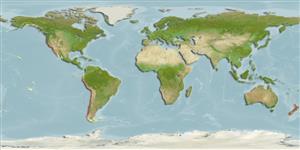Scyphozoa |
Semaeostomeae |
Pelagiidae
Environment: milieu / climate zone / depth range / distribution range
Ecology
Pelagic-neritic; depth range 0 - 50 m (Ref. 116114). Tropical; 0°N - 60°S, 86°W - 45°W
Southeast Pacific and Southwest Atlantic: from Ecuador to Chile, to Sao Paulo Brazil.
Length at first maturity / Size / Weight / Age
Maturity: Lm ? range ? - ? cm Max length : 100.0 cm WD male/unsexed; (Ref. 121705)
Up to 30 cm wide, almost hemispherical; tentacular lappets, 2 per octant broadly rounded, rhopalar lappets smaller; tentacles 3 in each octant; radial stomach pouches of epual width except the distal portion; exumbrella with 16 broad, radial bands of dark, brown colour with numerous light spots.
Maximum depth range from Ref. 122852. Common along coasts (Ref. 122852). Neritic, estuarine, potentially pathogenic (Ref. 116114). Two isolated findings recorded the species offshore over the shelf-break front (Ref. 122852).
Life cycle and mating behavior
Maturity | Reproduction | Spawning | Eggs | Fecundity | Larvae
Members of the class Scyphozoa are gonochoric. Life cycle: Egg is laid by the adult medusa which later develops into a free-living planula, then to a scyphistoma to a strobila, and lastly to a free-living young medusa.
Migotto, A.E., A.C. Marques, A.C. Morandini and F.L. da Silveira 2002 Checklist of the cnidaria medusozoa of Brazil. Biota Neotropica 2(1):1-31. (Ref. 813)
IUCN Red List Status
(Ref. 130435: Version 2025-1)
CITES status (Ref. 108899)
Not Evaluated
Not Evaluated
Threat to humans
Human uses
Fisheries: commercial
| FishSource |
Tools
More information
Trophic EcologyFood items (preys)
Diet composition
Food consumption
Predators
Population dynamicsGrowth
Max. ages / sizes
Length-weight rel.
Length-length rel.
Length-frequencies
Mass conversion
Abundance
Life cycleReproductionMaturityFecunditySpawningEggsEgg developmentLarvae PhysiologyOxygen consumption
Human RelatedStamps, coins, misc.
Internet sources
Estimates based on models
Fishing Vulnerability
High vulnerability (60 of 100).
Price category
Unknown.
